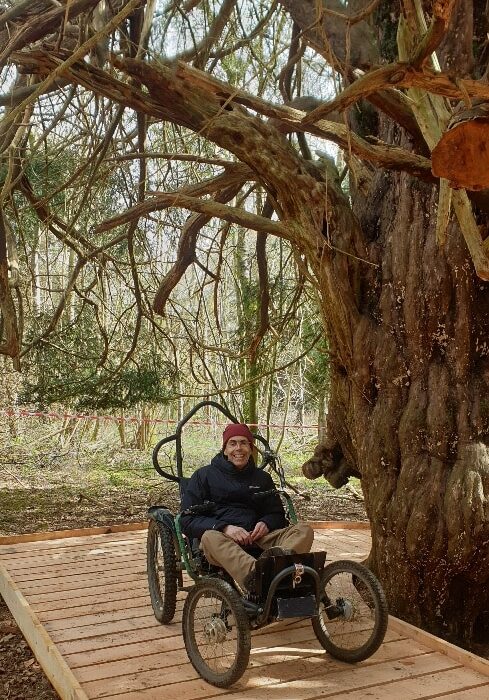
The Yew Tree Project
“Ancient trees are precious. There is little else on Earth that plays host to such a rich community of life within a single organism.” – David Attenborough
Find your way to the Yew Tree Project on the short largely accessible ‘Acorn Trail’ of less than a mile that starts just by of the natural play area behind the café. You’ll then be able to pick up signs to the Yew Tree Project.
The rarity of the ancient yew trees at Newland’s Corner makes it one of the most important sites for these precious trees in the whole country. Many of the trees have stood on this site for over a thousand years and they play a vital role in the local ecosystem as well as being enjoyed by many visitors every year.
Unfortunately, these precious ancient trees suffer from their popularity, as increased footfall compacts the soil around the tree, causing damage to the roots.
In order to protect the vulnerable trees, new strategies have been introduced to encourage people to use the designated footpaths and bridleways and so reduce the pressure on the trees. We have also provided a new boardwalk to give sustainable public access and enjoyment to three of the oldest trees on the site. This has been installed sensitively, avoiding any damage to tree roots.
Since the initial project, this site has gone on to see a blend of composts, soil amendments, and Air-spade techniques to restore compacted soil and promote the health of historically significant yew trees, while barriers were installed to protect their roots from future damage. Find out more.






The rarity of the ancient yew trees at Newland’s Corner makes it one of the most important sites for these precious trees in the whole country. Many of the trees have stood on this site for over a thousand years and they play a vital role in the local ecosystem as well as being enjoyed by many visitors every year.
Unfortunately, these precious ancient trees suffer from their popularity, as increased footfall compacts the soil around the tree, causing damage to the roots.
In order to protect the vulnerable trees, we have been advised to limit the footfall around them by the Yew Decline Working Group, in consultation with and supported by tree experts at the Ancient Yew Group, Ancient Tree Forum, Tree Council, Woodland Trust, Natural England and the National Trust.
The project is in line with the Ancient Tree Forum’s vision for ancient trees: ‘their wildlife, and their heritage and cultural values to be safeguarded now and in the future’. For more information go to ancienttreeforum.org.uk
New strategies have been introduced to encourage people to use the designated footpaths and bridleways and so reduce the pressure on the trees. We have also provided a new boardwalk to give sustainable public access and enjoyment to three of the oldest trees on the site. This has been installed sensitively, avoiding any damage to tree roots.
It is hoped these measures will allow the soil and roots to recover, helping to safeguard the future of these incredibly important ancient trees. Further measurements of progress such as soil sampling will be undertaken to understand the positive impact of these conservation strategies.
- Yews are the most long-lived trees in northern Europe, some are over 1,000 years old.
- The soil underneath is alive with a complex network of fine tree roots and fungal filaments called mycorrhizas.
- Yews flower in March and April. They are dioecious, meaning that male and female flowers grow on separate trees.
- Male flowers are small white-yellow globes whilst females are bud-like and scaly.
- All parts of the tree are poisonous to people – so don’t eat yew! Yew fruit is eaten by birds and small mammals, including dormice, and the leaves are eaten by caterpillars of the satin beauty moth.
- Because of its longevity and propensity for ‘layering’, yew has always been held sacred, symbolic of everlasting life, transformation, and rebirth. Layering is when branches grow down to the ground and then take root, creating a new tree, but still attached to the ‘mother tree’.
- Druid shamans used to inhale the pollen vapour in spring during their rituals to help them connect with the spirit world and the ancestors.
- In the Middle Ages, yew wood was used to make longbows and crossbows.
- The yew tree’s presence in churchyards has earned it the nickname ‘tree of the dead’.
- Anti-cancer compounds used in modern medicine are harvested from yew leaves.
This project was funded by the Surrey Hills Access for All fund. Read more about the project funding here.
The soil compaction and tree restoration received further funding by our Farming in Protected Landscapes fund. Find out more here.
This project was launched by Sir William Worsley, Chairman of the Forestry Commission and Ted Green MBE. Read the news story here.
